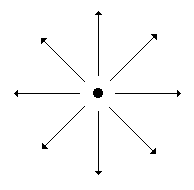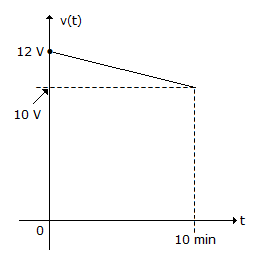Online Electronics and Communication Engineering Test - Previous Exam Papers Test 7
- This is a FREE online test. Beware of scammers who ask for money to attend this test.
- Total number of questions: 20.
- Time allotted: 30 minutes.
- Each question carries 1 mark; there are no negative marks.
- DO NOT refresh the page.
- All the best!
Marks : 2/20
Test Review : View answers and explanation for this test.

Given circuit after removing CE will behave as current-series feedback.
Overall voltage gain will decrease as feedback signal comes into picture and since it is current-series feedback, input impedance increases.
 ; which of the following figure shows an exact field distribution?
; which of the following figure shows an exact field distribution?
The given figure fails to show the symmetry with respect to Φ.

The figure shows symmetry with respect to f, also the length of arrow is decreasing away from the charge shows that magnitude E is decreasing away from line charge.
But problem with this figure is longest lines must be shown in most crowded region.

Here we use lines of fixed segments but different thickness. But this attempt also makes the region crowded near origin.

This figure shows compromise. A symmetrical distribution of lines (at every 45°) shows azimuthal symmetry and arrowheads show direction.
h(t) = e+atu(t) + eβtu(- t)
For h(t) to be stable h(t) dt < ∞
h(t) dt < ∞
It will happen when a is negative and β is positive.

Dual of R → G


 Damping ratio is:
Damping ratio is:
1 + G(s)H(s) = s2 + 2s + 2
ωn = 2 , 2εeωn = 2, εe =  = 0.707.
= 0.707.
- The reduction in h12 and Miller capacitance result in negligible reverse internal feedback.
- A's is large loads cannot be connected.
- As a narrow band amplifier, it provides small range of cμ is reduced.
- As a narrow band amplifier it provides small range of frequencies parameters the effect of cμ reduces.
Cascode is a wide band amplifier and it provides wide range of frequencies than CE stage and as  is large, large loads can be connected.
is large, large loads can be connected.
Asymptotes.
 (33, 48, 102, 158, 222, 229, 233, 243, 255); then the __________ and __________ minterms are grouped together into dual and variable __________ is reduced using the dual
(33, 48, 102, 158, 222, 229, 233, 243, 255); then the __________ and __________ minterms are grouped together into dual and variable __________ is reduced using the dualWe use Quine - McCluskey method of reduction :

We can observe that minterms 158 and 222 can be grouped together to reduce the variable 'B'.

Thus reflection coefficient =  = - 0.5
= - 0.5
Thus magnitude is 0.5 .
We have,
I = I0•(eV/nVT -1)
∴ 
For forward voltage greater than few teeth's of volts, I >> I0
∴ 
∴ Forward dynamic resistance,

= 34.3 Ω
Reverse dynamic resistance =  = 20 kΩ.
= 20 kΩ.

The power of the output process Y(t) is given by
Since bandwidth is 10 kHz, thus output power is 10 x 10-11 x 10 x 103 = 1 x l0-6 W.
 u(t) is stable, if __________ (n is even).
u(t) is stable, if __________ (n is even).h(t) =
consider 
ax = x
ax = x2
a = x

For h(t) to be bounded, exponential term should have a negative power.

i.e. e-t will have response as shown.
Hence  should be < 0
should be < 0
∴ a < 0.



Assertion (A): An unbiased p-n junction develops a built-in potential at the junction with the n-side positive and the p-side negative.
Reason (R): The p-n junction behaves as a battery and supplies current to a resistance connected across its terminals.






